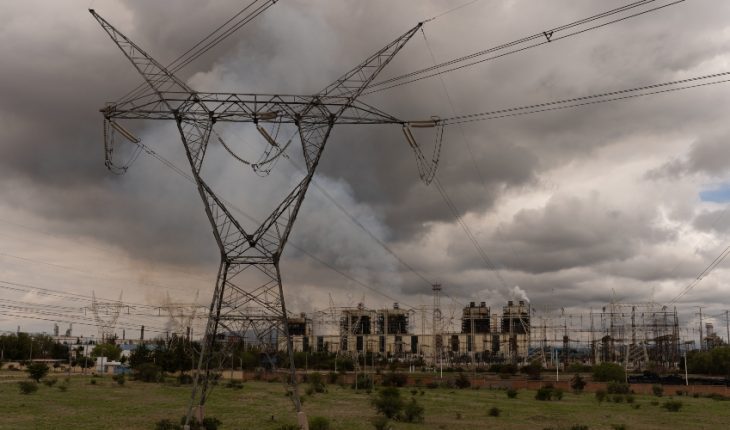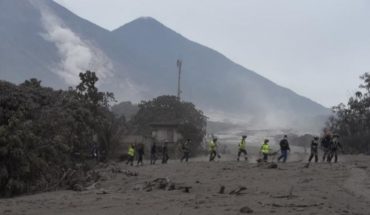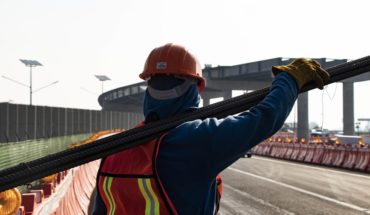March 28, 2021 was the most polluted day in the history of the Valley of Mexico. A swirl of dust—known as a hopper—was coupled with the smoke of industries and vehicles, and all the pollution that the activity of more than 20 million people produces in the air we breathe. The traditional “cream” that surrounds Mexico City, that kind of translucent hat of toxic compounds, became an ochre mist so dense that it gave the impression of being able to chew. The Angel of Independence, the Zocalo or the Chapultepec Forest seemed surrounded by an apocalyptic filter and from anywhere in the capital it was difficult to spot beyond a few blocks. The system that measures air quality in Mexico City sets a parameter in which more than 100 points are considered a health hazard. That day, for the first time since there were records, they exceeded 661.
The inhabitants of the Valley of Mexico are accustomed to toxic air. We breathe it every day. It enters our lungs, irritates them and inflames them. It causes coughing, shortness of breath, bleeding in the nose, irritation of the eyes. If it builds up, it can cause emphysema, chronic bronchitis, or heart problems. Atmospheric quality studies remind us that almost all standards are oversteered by the pollution we inhale. According to the 2018 Air Quality Report, the latest published by the Government of Mexico City, the world health organization (WHO) recommended sulphur dioxide rates increased seven times, ozone levels are almost doubled, and all national and international standards for the presence of PM10 and PM2.5 particles were passed. These particles are like microscopic droplets, so small that the body’s defenses are not able to filter them and that they cling like ticks into our respiratory system. A study by Adolfo Hernández Moreno, professor at the Universidad Autónoma Metropolitana, estimates that between 8,000 and 14,000 people die each year in the capital from poor air quality.
Every time an atmospheric contingency like last March 28 arrives, the CDMX government activates a plan: it cannot drive half the vehicles, outdoor activities are suspended, and polluting industries are asked to lower their production to avoid adding more poison to the air. That day one of the orders was directed towards the Francisco Pérez Ríos Thermoelectric Plant, located 8 kilometers southeast of Tula de Allende, Hidalgo: they had to reduce by 30% the burning of combustóleo, the main fuel that it uses to generate energy. Although there is a distance between the plant and the megalopolis of 83 kilometers, according to data from Dr. Horacio Riojas, Director of Environmental Health of the Center for Research in Population Health of the National Institute of Public Health (INSP), its emissions contribute 10% to the toxics that capitalists breathe daily.
March 28, 2021 was the most polluted day in the history of the Valley of Mexico. Photo: Bernat Parera.
The Tula plant, which opened in 1975, has turned its environment into one of the most polluted areas in the world by sulfur dioxide. According to Greenpeace, Tula ranks 23rd on the list of 50 critical points for its emissions of this type of polluting gases—Mexico is the fifth country that sends the most pollution into the atmosphere, second only to India, Russia, China and Saudi Arabia.
You may be interested: They decree environmental contingency in Salamanca by burning combustoleo in THERMOelectric of CFE
That’s why the most polluted day in Mexico City history for Lorenzo Herrán Hernández, a 64-year-old man who has his house and a small vegetable shop less than a mile from the thermoelectric plant, was one more day. He defines the gases he breathes as “that light that comes out and looks like white ash,” which ends up covering the car that parks outside his house, the nopales he grows and the clothes he leaves lying in the yard. Herrán Hernandez says that when the plant started working he saw a job opportunity. No one complained then, because this is a humble area, dedicated to agriculture, and the installation of the thermoelectric plant, which came together with a Pemex refinery, meant the creation of new jobs. No one explained that Bominthzá, a community of just over 3,000 inhabitants, would be within the most affected perimeter of one of the worst airy areas in the world. Even if they had known that the air they breathe was going to turn into poison, says Herrán Hernandez, they wouldn’t have protested either. “This is up to the government. What were we going to do?” he says.
From your home, a concrete construction of a plant, you can see the blue smoke that sprouts from the chimneys of the plant and that crosses the area towards Mexico City. The wind and orography of the region cause the toxics to make the journey to the mayoralties of the north of the megalopolis as if sliding down an imaginary slide. According to Oscar Ocampo, energy researcher at the Mexican Institute of Competitiveness (IMCO), what comes from Tula accounts for 56% of pm2.5 particles breathed in megalopolis, 43% of nitrogen oxides and 75% of sulfur dioxide. This, in his view, explains a surprising phenomenon: during the toughest moments of confinement for the COVID-19 pandemic in Mexico City, there was no noticeable decrease in the number of emissions even though mobility was drastically reduced.
Lorenzo Herrán, a 64-year-old man who lives less than a kilometer from the thermoelectric plant, defines the gases he breathes as “that light that comes out and looks like white ash.” Photo: Bernat Parera.
The Tula plant emits more than 130 thousand tons of sulphur dioxide among other polluting gases each year, according to a SEMARNAT report. If we kept that toxic in truck containers, we could line up from Mexico City to the vicinity of the thermoelectric plant itself. To house all the gases would take 5,000 football fields. And this happens while the legislation is being violated. On the one hand, the combustoleus burning doubles the sulphur emissions allowed by NOM-086-SEMARNAT-SENER-SCFI-2005 for critical areas, which is what the Tula area is considered. The document indicates that 2% sulfur sent into the atmosphere cannot be exceeded, but studies prepared by organizations such as the Mexico Climate Initiative (ICM) found that 3.9% is reached. On the other hand, your operating permit is only intended for natural gas. According to a transparency response obtained by the same group, the Energy Regulatory Commission only authorises the work of the plant with this cheaper and cleaner fuel. Most of its operation, however, is fueled by combustoleo, a residue of crude oil refining. In 2019, according to an ICM study, thermoelectric plant burned 69% combustoleum and only 31% natural gas.
The authorities have also questioned thermoelectric in recent years. In 2018, the Federal Commission for the Protection of Health Risks (COFEPRIS) had announced a “health alert”. A year later, pollution in the vicinity of Tula reached such an extent that the Ministry of Environment and Natural Resources (SEMARNAT) declared it an environmental emergency. His then starter, Victor Toledo, assured that the place could become “uninhabitable”. Soon after, he resigned.
Read: Santiago River: the 10-year hidden study that alerted Jalisco populations about polluting metals
“Nothing else made a statement, but there it was, only in comment,” says Gerardo Castillo, a 69-year-old pensioner and representative of the Tula River’s Citizen Participation Committee on Defense. He’s been part of the community all his life and words like “uninhabitable” make his hair stand on end. “We thought a federal government position would come, but unfortunately there it stayed,” he says.
The Federal Attorney’s Office for Environmental Protection (PROFEPA), however, came to close the plant’s treatment plants for irregularities in wastewater permits in 2018 and imposed a fine of almost four million pesos. It is now investigating the thermoelectric plant for its polluting emissions, following a complaint filed in August 2020.
But Tula contamination is not just a product of her thermoelectric plant. The municipality is the central point of a perfect storm that poisons the place by land, sea and air. To the effect of the Pemex plant and refinery is joined by the impact of the industrial zone, which has four cement mills, and the damage of the Endhó dam, converted into the toilet of Mexico City: this is where the megalopolis expels much of its black water. Its surroundings look like a beach where the effects of a shipwreck are scattered: plastic bags, slippers, children’s backpacks. In the sky, some birds accustomed to feeding on filth fly over the garbage that accumulates. Pollution, seen from this place, is a matter of round trip. Mexico City sends its trash through the water and Tula returns it in the form of a poisonous cloud.
Combustoleo in spite of everything
The big environmental problem of the Tula thermoelectric plant is the combustoleum, and it is linked to the activity of the Pemex refinery, as it is a waste that is generated when processing crude oil. The refining system makes them obtained from high ca productslighter, such as diesel gasoline, to other heavy, less efficient and more harmful gasoline, such as the combustoleus. Pemex’s unofficial sources explained that, daily, the refinery produces 250,000 barrels: 95 are regular gasoline, 10 premium gasoline, 60 intermediate distillates and another 100 combustoleus. Of these, 40,000 feed the Tula plant daily.
Read: Alert villagers ‘yellow smoke’ in Salamanca; municipality denounces Pemex refinery
In the face of waste generation there are few options available: burn it, as is done now, take it somewhere else or turn it into coke, another material that is used in industrial processes and which is eliminated sulfur in its processing. So far, Mexico has maintained the most polluting option as a priority. The Federal Energy Commission (CDE) argues that there is not enough natural gas to power the plant because in principle it should arrive from Tucson, Texas, through the Tuxpan-Tula pipeline, but a Hidalgo community’s rejection of the layout has been paralyzed for three years.
The Tula plant emits more than 130 thousand tons of sulphur dioxide among other polluting gases each year, according to a SEMARNAT report. Photo: Bernat Parera.
The reality is that the current system based on the combustóleo, with a sulphur content of almost 4%, violates any Mexican and international regulations. An example: since 1 January 2020, the International Maritime Organization has prohibited vessels from using fuel incorporating more than 0.5% sulfur. Tula quadruples the rate allowed on the high seas.
“The combustoleum is harmful because its burning releases three substances: PM10, PM2.5 and sulfur dioxide particles. They clog the airways and inflame them, as well as generate acid rain and cause gases that accelerate the greenhouse effect,” says Victor Ramírez, a member of the Climate Initiative.
In humans the impact of these pollutants is measured in the long term and by accumulation. According to Dr. Horacio Riojas of the INSP, the main effect is airway irritation. This can lead to ills such as Chronic Obstructive Pulmonary Disease (COPD) and aggravations in sick or elderly people. The problem is that the real impact of pollution on the area has never been studied. “All these contaminants have been studied a lot over the past 40 years. Long-term life expectancy decreases and are linked to avoidable deaths. There are many health risks,” Riojas says.
In Tula, according to data from the Hidalgo Ministry of Health, the rate of pneumonia and bronchopneumonies is almost nine times higher than that of the state average (776 cases per 100,000 inhabitants versus 87.8). But one of the problems in raising awareness of these risks is that it is impossible to find a death certificate with cause of death: “poor air quality.” It’s not mathematical calculations. It’s about possibilities. Just as a person can smoke throughout his or her life without getting sick, poisoned air can build up in the lungs without causing serious ills or being the trigger for a deadly disease. Dr Riojas explains that the scientific community has established an 8% more mortality for each 10-point increase in PM10 particles. If someone spends a lot of time breathing these particles, their chances of dying earlier than planned increase.
Ground Zero
Jerónima Serrano Ruiz, 48, lives in the zero zone of Tula pollution: Praderas de Llano, a small community of only 150 inhabitants separated from the thermoelectric plant by a road. This is a residential place where there is a certain abundance for the jobs of the plant in the houses with garden surrounded by walls. The development clashes with the fact that here, according to a study promoted by the Air Quality Observatory and developed by the Climate Initiative of Mexico, the presence of sulfur in the environment doubles what is allowed by the standard. You don’t just breathe, you smell. “At night it falls like acid. They rust down to cars and clothes. We put the picture for the cars, so they don’t fall,” serrano Ruiz says. At the epicenter of Tula contamination one can sunbathe in a house with swimming pool.
“There are people who say they get sick from pollution and complain, but nobody does anything,” Serrano Ruiz says. She has been in charge of a mechanical equipment store for seven years and most of her customers are refinery or thermoelectric workers. Your complaint, however, is not environmental. That’s what he’s used to. What bothers him is that his daughter studied so she could be employed at headquarters, but she never had the choice. “If you don’t pay or don’t have palthey don’t hire you. Of all those who studied with my daughter, none of them came in. They just called those who are children they’re already working on,” he says.
The thermoelectric plant employs 800 people and to that we must add the possibles that are contracted when works have to be done and those who work in the refinery. Its impact on the area is such that there are even several housing units dedicated exclusively to these workers. In addition to direct posts, the arrival of employees also moves the economy in an agricultural area where it is normal to collect the minimum wage, which does not reach 3,000 pesos. It’s apartment rent, restaurants, food sales. Essential money in a state like Hidalgo, where four out of ten people are poor, according to data from the 2018 Coneval. That is why it is common for one to find gestures of suspicion and a blunt answer in the nearby municipalities about the pollution generated by thermoelectric planting: if there is no industry there is no work. The certainty of necessity coexists with the story of acid rain, rust and odors is repeated throughout the perimeter of the plant. Also resignation to something that comes from the government, which they see as a monster alien to which they should not contradict.
The certainty of necessity coexists with the story of acid rain, rust and odors is repeated throughout the perimeter of the plant. Photo: Bernat Parera.
Tula’s thermoelectric plant is close to half a century old, although experts estimate that these infrastructures should have a lifespan of about 30 years. Although some improvement works have been carried out, several environmental organizations consider it to be already expired. The CFE has closed information about the plant, arguing that it is “industrial secrecy”. An already retired extra-collector, who spoke on an anonymity, said that the machinery was bought with technology that was already outdated at the time and that the only explanation that exists to justify the operation of the plant is that “we have a combustoleo and we have to take advantage of it.”
The recent Electricity Industry Act has also been a guarantee that Tula will continue to operate. Previously, due to the higher marginal cost, thermoelectric plants that use combustoleo were the last to enter the system. However, the new regulations prioritize them over privately owned power generators. More operation involves more burnt fuel, more sulfur and PM10 and PM2.5 particles. Environmental organizations have called for the combustoleum to be replaced by natural gas, which would be a cleaner energy source. But, the problem of what to do with the residue that causes the treatment of crude oil would remain.
This does not appear to be a priority of the federal government, which in internal documents recognizes that it does not plan to touch the production of combustoleo at least until 2024, when Andrés Manuel López Obrador finishes his term. Recently, the president traveled to Tula to announce his decision to finish the co-equipment plant, which could serve to partly solve the problem of combustoleus contamination. But this is a promise since the time of Felipe Calderón.
Lorenzo Herrán Hernández, the man accustomed to the mist that sprouts from the chimneys and becomes white dew on his car, his nopales and the clothes he tends in the yard, recognizes that there was a time when he even thought about leaving the community. It was two decades ago, when some trucks arrived calling for immediate evacuation because they feared that some of the gas pipelines that were going through the surrounding area could explode. Remember the scare and pick up as little as you could at full speed to run away. In the end he stayed here with his whole family, in his small concrete house, in front of the fruit and vegetable shop. Your concern now is that the Army will stop testing you at home. Hidalgo is the most active state in Huachicol, the fuel theft, and Says Herrán Hernandez that the military entered his home three times in recent months. About the invisible, that poison that breathes every day, says that when you get 60 years of something you have to die.
* This report is part of Colapso, a cross-platform drug project in collaboration with various media outlets, including Animal Politics, to understand Mexico from the environment, natural resources and climate emergency.
What we do at Animal Politics requires professional journalists, teamwork, dialogue with readers and something very important: independence. You can help us keep going. Be part of the team.
Subscribe to Political Animal, receive benefits and support free journalism #YoSoyAnimal.





